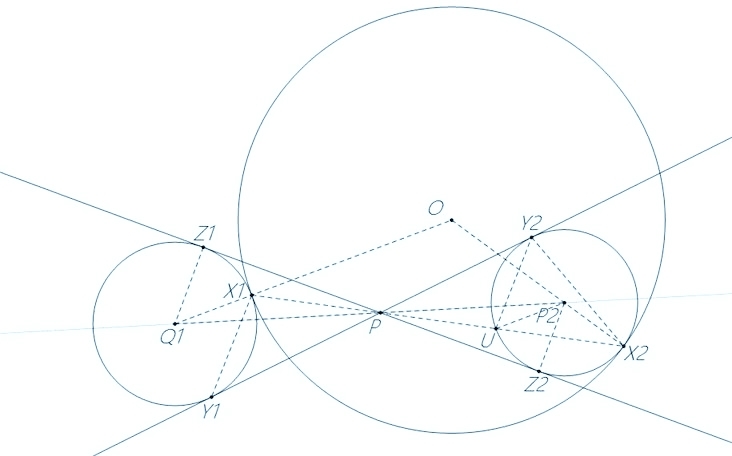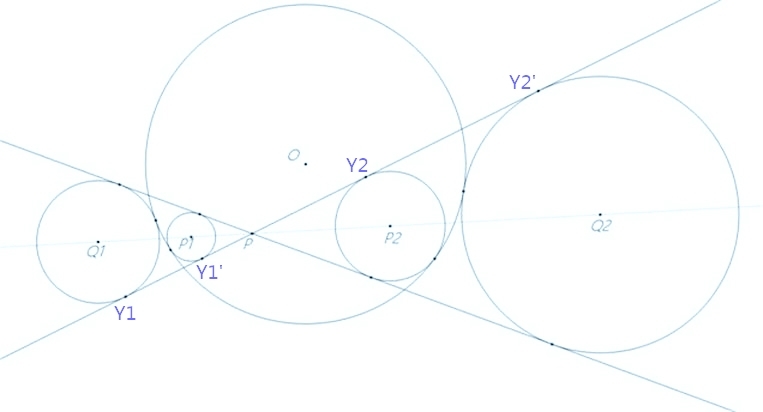9 circle problem
The intersection point
P
of two straight lines
l,m
is inside the given circle
O
. 8 circles tangent the lines
l,m
and circle
O
, the circles have numbers 1-8 (see the picture). We know the radii of three circles, the centers of which lie on the bisector
b
of the angle between lines
l,m
. Find the radius of the fourth circle, whose center lies on the bisector
b
.
Appendix. Find the product as a function from . is the radius circle O , - distanse from centrum of circle O to intersection point of two straight lines l,m .
Problem is original.
The answer is 12.
This section requires Javascript.
You are seeing this because something didn't load right. We suggest you, (a) try
refreshing the page, (b) enabling javascript if it is disabled on your browser and,
finally, (c)
loading the
non-javascript version of this page
. We're sorry about the hassle.
Well,to solve this mysterious problem,let's first prove a lemma .
Lemma P Y 1 ⋅ P Y 2 = P 's power of ⊙ O ( < 0 ) .
Proof First,let's show that P X 1 ⋅ P X 2 = P 's power of ⊙ O .It's equivalent to show X 1 , P , X 2 are collinear.Note that Q 1 Z 1 ⊥ Z 1 Z 2 and P 2 Z 2 ⊥ Z 1 Z 2 give us Q 1 Z 1 / / P 2 Z 2 ⟹ P 2 Z 2 Q 1 Z 1 = P P 2 P Q 1 ⟹ P 2 X 2 Q 1 X 1 = P P 2 P Q 1 ⟹ X 1 O Q 1 X 1 ⋅ X 2 P 2 O X 2 ⋅ P Q 1 P 2 P = 1 .Hence by Menelaus's Theorem,we have X 1 , P , X 2 are collinear.
Now let U denotes the the second intersection of the line X 1 P X 2 and ⊙ P 2 . A homothetic transformation whose centre and ratio are P and − R ⊙ Q 1 R ⊙ P 2 respectively helps us throw Y 1 , X 1 to Y 2 , U ,respectively.Thus, Y 1 X 1 / / Y 2 U ⟹ ∠ X 1 Y 1 P = ∠ U Y 2 P = ∠ Y 2 X 2 U = ∠ Y 2 X 2 P ⟹ X 1 , Y 1 , X 2 , Y 2 are concyclic ⟹ P Y 1 ⋅ P Y 2 = P X 1 ⋅ P X 2 = P 's power of ⊙ O . □
Come back

Using the lamma,we have P Y 1 ⋅ P Y 2 = P Y 1 ′ ⋅ P Y 2 ′ = P 's power of ⊙ O ⟹ P Y 1 P Y 1 ′ = P Y 2 ′ P Y 2 ⟹ R ⊙ Q 1 R ⊙ P 1 = R ⊙ Q 2 R ⊙ P 2 . So r 2 = r 4 ⋅ r 8 r 6 = 1 2
About the Appendix
r 3 r 4 r 5 r 6 = ( R 2 − d 2 ) 2 (easy to get from our lemma,as you can express r 3 r 5 and r 4 r 6 as t a n 2 θ ⋅ ( R 2 − d 2 ) and c o t 2 θ ⋅ ( R 2 − d 2 ) respectively,here θ is a half of the acute angle that formed by l and m in the picture.)